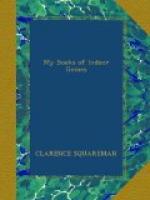When the game is ended, the forfeits that have been lost must be called.
* * * * *
THE MAGIC WHISTLE
All the players but three stand in two rows facing each other. One player sits at the end of the two rows, another leads a third player into the room and makes him kneel down before the player who is seated, and who is called the President.
The President then proceeds to make all sorts of “magic” passes over the kneeler’s face, back, and hands. While he is doing this, the boy who led the victim in fastens a whistle to his coat. It must be slung on to a piece of string or tape, and fastened very loosely, so that it can be easily grasped and yet will not knock against the wearer’s back.
The whistle is then blown by the boy who attached it, and the kneeling boy is told to rise and search for the magic whistle. The players who stand on each side must hold their hands before their mouths and pretend to blow whenever the whistle is blown, which must be as often as any one can get a chance without being found out.
The victim will search all along the rows trying to find the magic whistle, and it will be some time before he discovers that it is pinned to his own coat.
* * * * *
A RUNNING MAZE
Form a long line of children, one behind the other. The leader starts running, and is followed by all the rest. They must be sharp enough to do exactly as the leader does.
After running for a moment or two in the ordinary running step, the leader changes to a hopping step, then to a marching step, quick time, then to a marching step, slow time, claps and runs with hands on sides, hands on shoulders, hands behind, etc.
Finally, the leader runs slowly round and round into the center, and can either wind the children up tightly or can turn them on nearing the center and run out again. For another change the long line can start running and so unwind the spiral.
* * * * *
THE COACH AND FOUR
Two children stand hand-in-hand, side by side. These are the front horses. Two others, close behind, stand also hand-in-hand and side by side. These are the back horses.
Slip reins over the left arm of one of the front horses, and over the right arm of the other. The two back horses hold on the reins, standing inside them. A driver must then be chosen, who gathers up the reins in his left hand and in his right hand holds a whip.
Running beside him, equipped with a horn and parcels and letters, is another child, who acts as guard or conductor. The rest of the children form village streets, by standing in rows facing one another.
The coach and four, with the driver and guard, gallop about the room and through the villages, the guard blowing his horn and tossing out a paper or letter here and there.




